Barrie Dentist: On the topic of dental bridges, or, “What’s your pont?”
Posted: June 30, 2014
Last Modified: June 6, 2022
A dental bridge is not hard to understand, although over time they are less and less frequently done. They are one of three different ways to replace teeth (the other two being implants and removable dentures), and in the spectrum of dental prostheses done in Barrie, bridges still occupy an important niche. Herewith, a summary of the important things to consider before you get a bridge:
To make things easier, let’s just show a photo of a model bridge.
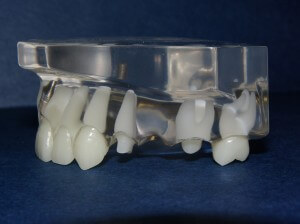
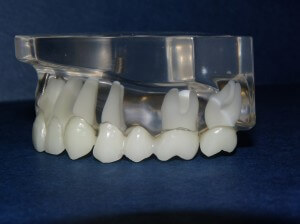
In these photos, you can see that a bridge replaces a missing tooth by connecting the replacement tooth to the real teeth on either side of the space. The bridge is cemented onto the real teeth and cannot be removed without being destroyed. It is very much like a bridge on a road – a span supported at both ends.
Advantages:
A bridge is non-removable, so there is no fear of accidental loosening as there is in a removable partial denture. This also provides a more realistic chewing experience over that of a removable denture.
Bridges are typically fabricated in a dental laboratory, and take about two weeks to turn around. This is much faster than dental implants, which require several months of bony healing before a tooth can be attached to an implant.
There is good evidence to show that bridges do last quite a while, especially if none of the supporting teeth have had a root canal.
Disadvantages:
Dental bridges require a significant amount of tooth structure removal from the supporting teeth, and this damage may be too much for a nerve to handle. If this is the case, the tooth will require a root canal procedure in order to be saved.
The end result of a bridge is that teeth are tied to other teeth. This is not an ideal situation, because anything that goes wrong with one of the teeth (for example, porcelain fracture or dental decay) will potentially result in the loss of the entire bridge.
The longevity of bridges is also not expected to equal that of an implant, so over the long term, despite the lower initial cost, bridges are expected to cost more.
Cleaning under a bridge is also more complicated than for an implant, because floss must be passed under the bridge in order to clean properly. This is not a difficult manoeuvre, but an often overlooked step that can result in dental decay of the supporting teeth.
So, when are the optimal situations for a bridge? Basically, bridges play second fiddle to implants unless there is a technical reason that an implant cannot be done – this can range from insufficient space for an implant to a high-risk medical history that may prevent normal implant healing. Below is a case that was completed in our office.
Here is the preoperative view of the space in question. In this case, a bridge was a good choice because:
– the space was insufficient to accommodate an implant
– the tooth behind the space had a large enough filling to warrant a crown
Before the bridge: a one-tooth space too small to fit an implant. A dental bridge became the first choice for tooth replacement.
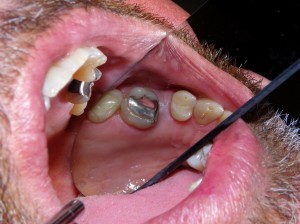
Tooth preparation: the teeth adjacent to the space were shaved down in order to make room for the bridge. Crucially, there needs to be parallelism, or draw, on both of the teeth so that the bridge can be inserted as a single piece. A mould of the teeth is taken (an impression), and sent to a dental laboratory for fabrication.
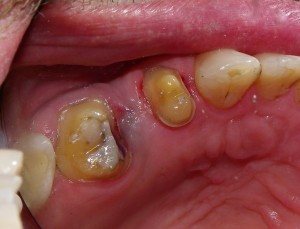
Temporization: during the two-week period that is required for bridge fabrication, a temporary bridge is made for the patient and cemented with a weak temporary cement.
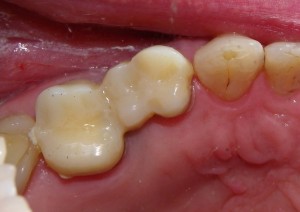
Final cementation: the final bridge is cemented onto the teeth. Upon removal of the temporary bridge, we ensure that the tooth has been cleaned by means of air abrasion. A suitable cement is then used to adhere the bridge to the teeth and the excess is cleared away.
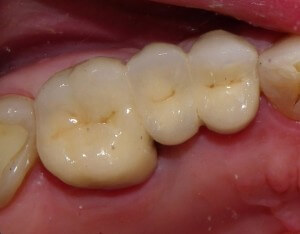
So that’s the story behind a dental bridge – pretty simple technically, the bigger challenge is using bridges in the proper situations. As in all aspects of dentistry, it is the planning that is more difficult than the execution, so a proper evaluation is essential before proceeding with anything. For a comprehensive examination and treatment plan, please contact us! We’d love to be your Barrie dentist.


